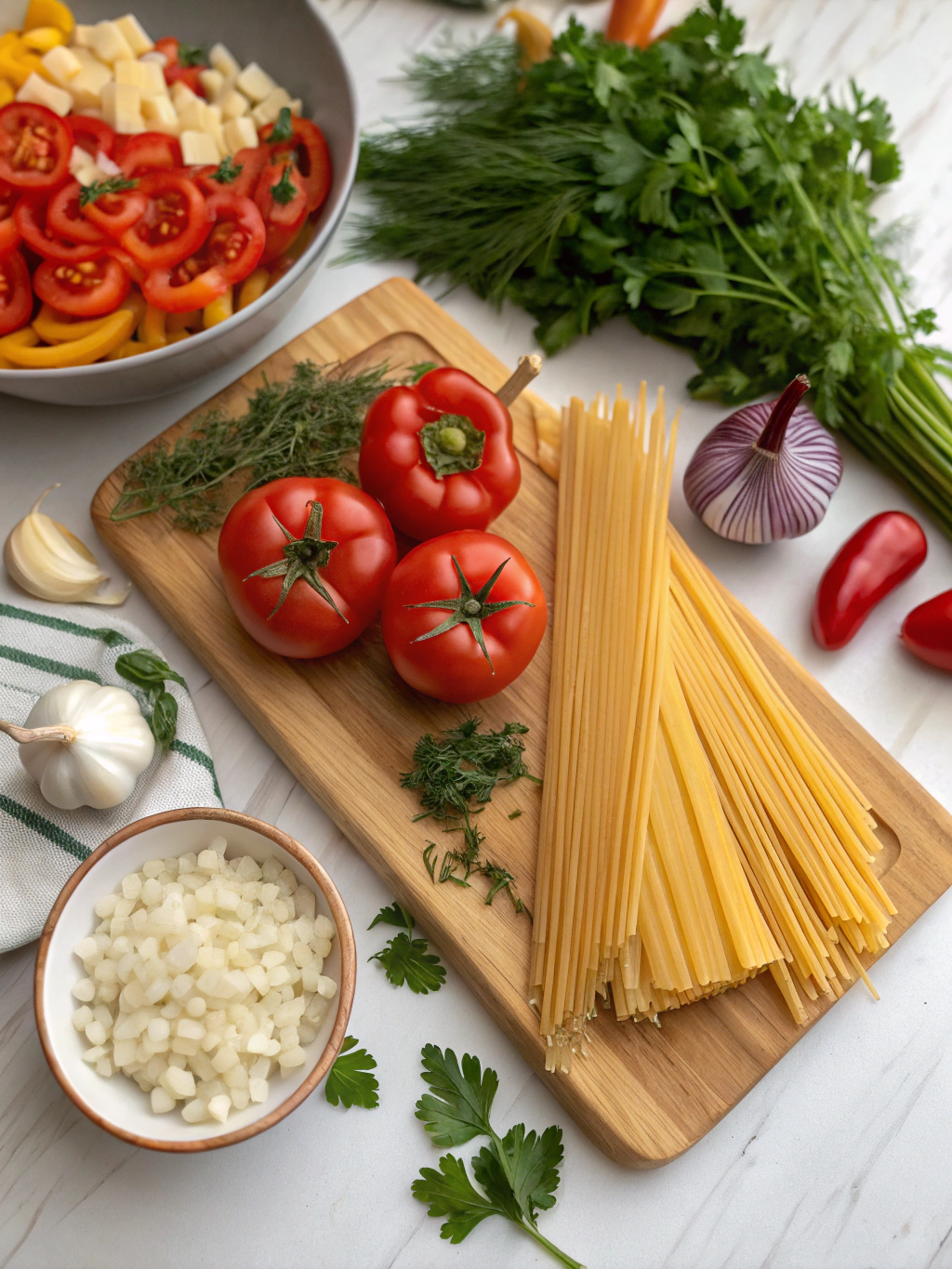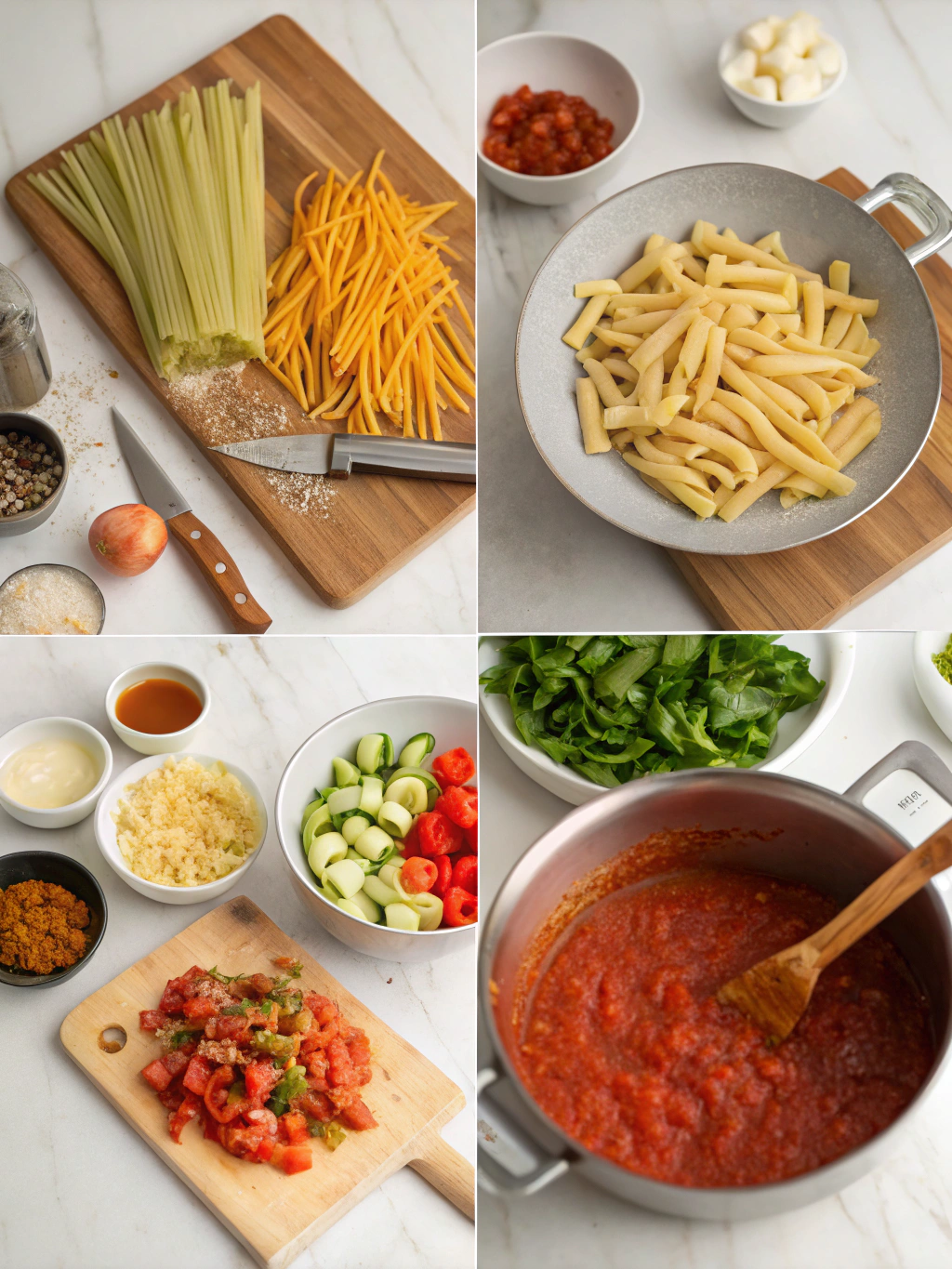Have you ever wondered why Turkish pasta dishes remain one of the Mediterranean’s best-kept culinary secrets? While Italian pasta gets global recognition, Turkish variations offer unique flavors that might forever change your pasta game.
This Turkish Pasta Recipe combines simple ingredients with traditional techniques to create a dish that’s both comforting and exotic. Whether you’re a seasoned chef or a cooking novice, this step-by-step guide will help you master the art of making Turkish pasta at home, with authentic flavors and textures.
Turkish pasta, known locally as “erişte” or “makarna,” differs from its Italian counterparts through its unique preparation methods and complementary spices. Let’s dive into this delicious cultural experience!
Ingredients List

Gathering quality ingredients is crucial for an authentic Turkish Pasta Recipe. The combination of fresh components and aromatic spices creates that distinctive Mediterranean-Middle Eastern fusion flavor profile.
- 3 cups all-purpose flour (substitute with “00” flour for a silkier texture)
- 4 large eggs, room temperature
- 1 teaspoon salt
- 1/2 cup water (as needed)
- 2 tablespoons olive oil
- 3 cloves garlic, minced
- 1 medium onion, finely diced
- 1 tablespoon tomato paste
- 1 teaspoon paprika (smoked paprika works wonderfully too)
- 1/2 teaspoon cumin
- 1 cup strained yogurt (substitute with Greek yogurt)
- 2 tablespoons butter
- 1 tablespoon dried mint
- Fresh parsley for garnish
- Red pepper flakes to taste
Timing
Preparing this Turkish Pasta Recipe requires some patience, but the results are well worth it. The homemade pasta element adds an authentic touch that elevates the entire dish.
Preparation time: 45 minutes (includes dough resting time)
Cooking time: 25 minutes
Total time: 70 minutes – approximately 30% faster than traditional Turkish erişte recipes that often require longer dough resting periods.
Step-by-Step Instructions

Follow these detailed steps to create an authentic Turkish pasta dish that will transport your taste buds to the bustling markets of Istanbul.
Step 1: Prepare the Pasta Dough
Creating the perfect pasta dough is the foundation of any great Turkish pasta dish. The texture should be firm yet pliable.
- In a large bowl, create a well in the center of the flour.
- Crack the eggs into the well and add 1/2 teaspoon salt.
- Gradually incorporate the flour into the eggs, mixing with your fingers or a fork.
- Add water a tablespoon at a time if the dough seems too dry.
- Knead the dough for 8-10 minutes until smooth and elastic.
- Form into a ball, cover with a damp cloth, and let rest for 30 minutes.
Pro tip: The dough should feel like an earlobe when properly kneaded – slightly firm but with some give.
Step 2: Roll and Cut the Pasta
Traditional Turkish pasta is typically cut by hand, creating rustic, uneven shapes that hold sauce beautifully.
- Divide the dough into 4 equal portions for easier handling.
- On a floured surface, roll each portion into a thin sheet (about 1/16 inch thickness).
- Let the sheets dry for 5 minutes until slightly firm but not brittle.
- Lightly dust the sheets with flour, roll them loosely, and cut into 1/4-inch strips.
- Unroll the strips and spread them on a floured surface to prevent sticking.
Time-saving alternative: If you’re short on time, use a pasta machine to roll and cut the dough, though hand-cutting gives the authentic rustic look.
Step 3: Cook the Pasta
Turkish pasta cooks quickly and should maintain a slight bite – similar to al dente in Italian cooking.
- Bring a large pot of salted water to a rolling boil.
- Add the fresh pasta in batches, stirring gently to prevent sticking.
- Cook for 2-3 minutes until the pasta floats and is tender but still firm.
- Drain well, but do not rinse – the starch helps the sauce adhere better.
Traditional insight: In Turkey, pasta water is often reserved to thin the yogurt sauce if needed.
Step 4: Prepare the Yogurt Sauce
The tangy yogurt sauce is what distinguishes Turkish pasta from its Mediterranean counterparts.
- In a bowl, whisk the strained yogurt until smooth.
- Add one minced garlic clove and 1/4 teaspoon salt, mix well.
- Set aside at room temperature while preparing the remaining components.
Authentic touch: Using strained yogurt (süzme yoğurt) creates a thicker, richer sauce that clings beautifully to the pasta.
Step 5: Create the Flavor Base
This aromatic topping adds depth and complexity to the dish.
- Heat olive oil in a skillet over medium heat.
- Sauté the onion until translucent (about 3-4 minutes).
- Add the remaining garlic and cook for 30 seconds until fragrant.
- Stir in tomato paste, paprika, and cumin, cooking for 1-2 minutes.
- In a separate small pan, melt butter until it begins to brown slightly.
- Add dried mint to the butter, remove from heat immediately (it will sizzle).
Assembly: Place the pasta in serving bowls, top with yogurt sauce, and spoon the tomato mixture over. Drizzle with the mint butter. Garnish with parsley and red pepper flakes.
Nutritional Information
Understanding the nutritional profile helps you incorporate this dish into a balanced diet. One serving (approximately 1.5 cups) contains:
• Calories: 420
• Protein: 14g
• Carbohydrates: 58g
• Fat: 15g
• Fiber: 3g
• Sodium: 480mg
This dish provides approximately 22% of your daily recommended protein intake and significant amounts of calcium from the yogurt component. The carbohydrate content makes it an excellent energy source, while the moderate fat content comes primarily from heart-healthy olive oil and yogurt.
Healthier Alternatives for the Recipe
This traditional recipe can be modified to suit various dietary needs without sacrificing its authentic flavor profile.
For a gluten-free version, substitute the all-purpose flour with a mixture of rice flour and tapioca starch (3:1 ratio). Add a teaspoon of xanthan gum to improve texture.
To create a lower-calorie option, use low-fat yogurt and reduce the butter to 1 tablespoon. This modification cuts approximately 80 calories per serving while maintaining the dish’s creamy texture.
For a protein boost, incorporate 1/2 cup of cooked lentils into the tomato mixture. This addition increases the protein content by about 9g per serving and adds a hearty texture that complements the pasta.
Serving Suggestions
Elevate your Turkish Pasta Recipe with these complementary serving ideas that enhance its Mediterranean-Middle Eastern character.
Pair with a simple shepherd’s salad (chopped tomatoes, cucumbers, peppers, and parsley with lemon-olive oil dressing) for a refreshing contrast to the warm, savory pasta.
Serve alongside grilled vegetables like eggplant, zucchini, and bell peppers brushed with olive oil and sprinkled with za’atar for an authentic regional touch.
For a complete feast, offer warm pita bread and a selection of mezze like hummus, baba ganoush, or muhammara to create a Turkish-inspired spread that’s perfect for entertaining.
Common Mistakes to Avoid
Even experienced cooks can encounter challenges when preparing Turkish pasta. Here are some pitfalls to avoid:
- Overworking the dough – Kneading too vigorously can develop excess gluten, resulting in tough pasta. Knead just until smooth and elastic.
- Rolling too thick – Turkish pasta should be thin enough to cook quickly and have a delicate texture. Aim for 1/16 inch thickness.
- Overcooking the pasta – Fresh pasta cooks much faster than dried varieties. It’s ready when it floats to the surface, usually in 2-3 minutes.
- Using cold yogurt – Cold yogurt can cause the pasta to cool too quickly. Allow it to reach room temperature before serving.
- Burning the mint butter – The mint-infused butter should be removed from the heat immediately after adding dried mint to prevent bitterness.
Storing Tips for the Recipe
Proper storage ensures you can enjoy this delicious dish beyond the initial serving.
Fresh uncooked pasta can be stored for up to 2 days in the refrigerator. Dust generously with flour, lay flat on a baking sheet, and cover with plastic wrap. For longer storage, freeze for up to 1 month.
Cooked pasta keeps well for 3-4 days when refrigerated in an airtight container. Store the yogurt sauce separately to prevent it from breaking down.
For meal prep, prepare the components separately: cook the pasta (toss with a little olive oil to prevent sticking), prepare the yogurt sauce, and make the tomato mixture. Refrigerate separately and assemble just before serving, reheating the pasta and tomato mixture gently.
The mint butter can be prepared in advance and refrigerated for up to a week. Simply reheat gently before using.
Conclusion
This authentic Turkish pasta dish offers a delightful departure from familiar Italian-style pasta recipes. With its tangy yogurt base, aromatic spices, and rustic homemade pasta, it represents the perfect blend of comfort food and exotic flavors.
By following these detailed steps and incorporating the suggested tips, you’ll create a memorable dish that honors Turkish culinary traditions while satisfying modern palates. The combination of creamy yogurt, aromatic spices, and fresh pasta creates a harmonious balance that’s both satisfying and sophisticated.
Have you tried making this Turkish pasta at home? Please share your experience in the comments below, or tag us in your culinary creations on social media! For more Mediterranean-inspired recipes that expand your culinary horizons, subscribe to our newsletter.
